
Lasers in Outer-Space
However most of what fans of these films get to see has remained in the realm of fiction, since many of the dramatic effects that they so enjoy have no basis in real science. In the vacuum of outer space, where scattering centers – such as dust particles – capable of refracting incident light are few and far between, laser ‘beams’ would be imperceptible. Owing to the paucity of oxygen, explosions would be equally unimpressive, and given the tenuous nature of the interplanetary medium, they could never furnish the deafening soundscapes that are a staple ingredient of both Star Trek and Star Wars in the cinema Here on Earth of course, the laser has become an indispensable part of our everyday lives. Every time we make a purchase in a supermarket a laser scans the barcode on the item at the checkout. Our bank cards and credit cards are embossed with holograms imprinted by lasers, and laser pointers have long replaced the wooden pointers some of us remember from our schooldays. In consumer electronics, communications and precision measurement technologies, in industry, medicine and research, lasers are now ubiquitous.

This artistic representation shows the Extremely Large Telescope in operation on the Cerro Armazones in northern Chile. The telescope uses laser beams to simulate fixed stars in the sky, which serve as orientation points for observing the real stars. Picture: ESO
And they have indeed found a range of applications in the realm first explored by the authors of science fiction – in space. To mention only one example, the European Southern Observatory’s Very Large Telescope (VLT), located in the Atacama Desert in Chile, uses laser beams to minimize errors in determining the precise positions of stars. The characteristic twinkling of stars is caused by turbulence in the atmosphere and limits the accuracy of astrometric observations. To combat this effect, a laser beam with precisely known properties can be projected on the night sky to serve as a calibration standard. Since the position of the laser spotlight is precisely known, the atmospherically induced distortions can be corrected for, yielding crisper, sharper images of the targets of interest.









